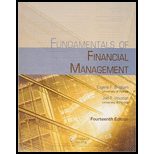
To explain: The
Introduction:
Opportunity cost: The opportunity cost refers to the cost which an alternative investment of the similar risk had given. With the help of opportunity cost, the investor can choose the better lender as the best
Time-value of money analysis: The time-value of money analysis refers to that analysis which is done to understand the change in value of money with time. With the help of this analysis, it is determined that whether the value of money is increased or decreased with time. This analysis is used in financial and investment decisions and is very helpful for financial users and investors.
Answer to Problem 1Q
- The opportunity cost refers to that cost which is left out to choose an alternative of the similar type and risk. If the risks associated with two options are the same and the individual has to choose one, the cost associated with that thing which is left is the opportunity cost.
- That is why opportunity cost is also called as the alternative cost.
- The opportunity cost plays an important role in the decisions of the user and in many other management decisions.
- The time value of money analysis is used by the investors. With the help of opportunity cost used in the time value of money analysis, the investors can choose the lenders which will give the best rate of return. When that option is chosen which gives the best rate of return, the future value of money is increased.
- The opportunity cost is shown for every
cash inflows andcash outflows on a time line. - In all the given situations, the interest rate is utilized as the single number.
Explanation of Solution
- The opportunity cost is a very important factor in making
financial and management decisions. - The time value of money analysis is done with the help of opportunity costs, by which the investors are able to make better decisions that helps them in earning more value of money in future.
- The time line is the visual representation of the time value of money analysis. The time line represents the time periods and the value of cash flows for that period with the interest rate.
- The single number which is used is the rate of interest, as the rate of interest is an important factor in this analysis.
Thus, the opportunity cost is the alternative cost, it is an important factor in time value of money analysis, and the interest rate is the single number used.
Want to see more full solutions like this?
Chapter 5 Solutions
Fundamentals Of Financial Management
- What is the finance ? tell about its significant.arrow_forwardTake value of 1.01^-36=0.699 . step by steparrow_forwardsolve this question.Pat and Chris have identical interest-bearing bank accounts that pay them $15 interest per year. Pat leaves the $15 in the account each year, while Chris takes the $15 home to a jar and never spends any of it. After five years, who has more money?arrow_forward
 Cornerstones of Cost Management (Cornerstones Ser...AccountingISBN:9781305970663Author:Don R. Hansen, Maryanne M. MowenPublisher:Cengage Learning
Cornerstones of Cost Management (Cornerstones Ser...AccountingISBN:9781305970663Author:Don R. Hansen, Maryanne M. MowenPublisher:Cengage Learning Managerial Accounting: The Cornerstone of Busines...AccountingISBN:9781337115773Author:Maryanne M. Mowen, Don R. Hansen, Dan L. HeitgerPublisher:Cengage Learning
Managerial Accounting: The Cornerstone of Busines...AccountingISBN:9781337115773Author:Maryanne M. Mowen, Don R. Hansen, Dan L. HeitgerPublisher:Cengage Learning EBK CONTEMPORARY FINANCIAL MANAGEMENTFinanceISBN:9781337514835Author:MOYERPublisher:CENGAGE LEARNING - CONSIGNMENT
EBK CONTEMPORARY FINANCIAL MANAGEMENTFinanceISBN:9781337514835Author:MOYERPublisher:CENGAGE LEARNING - CONSIGNMENT




